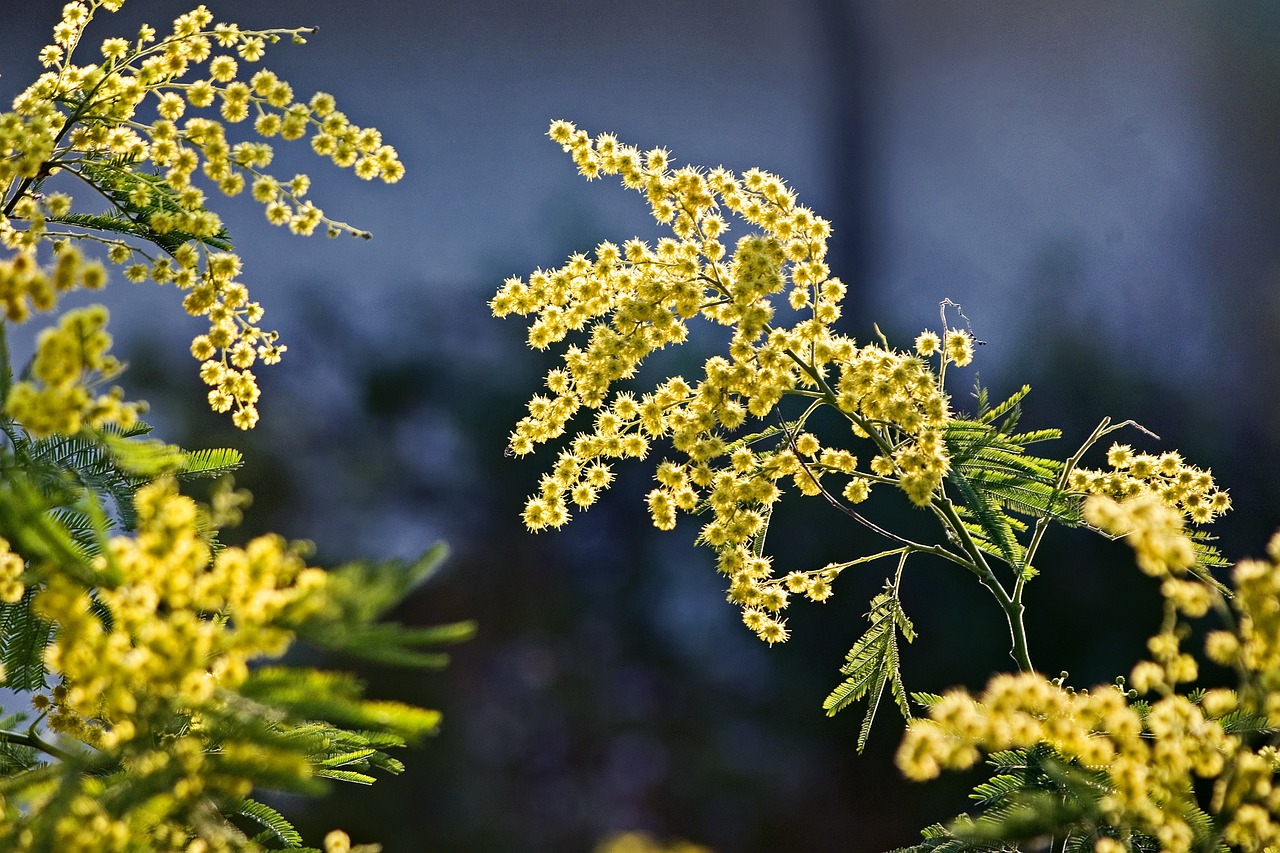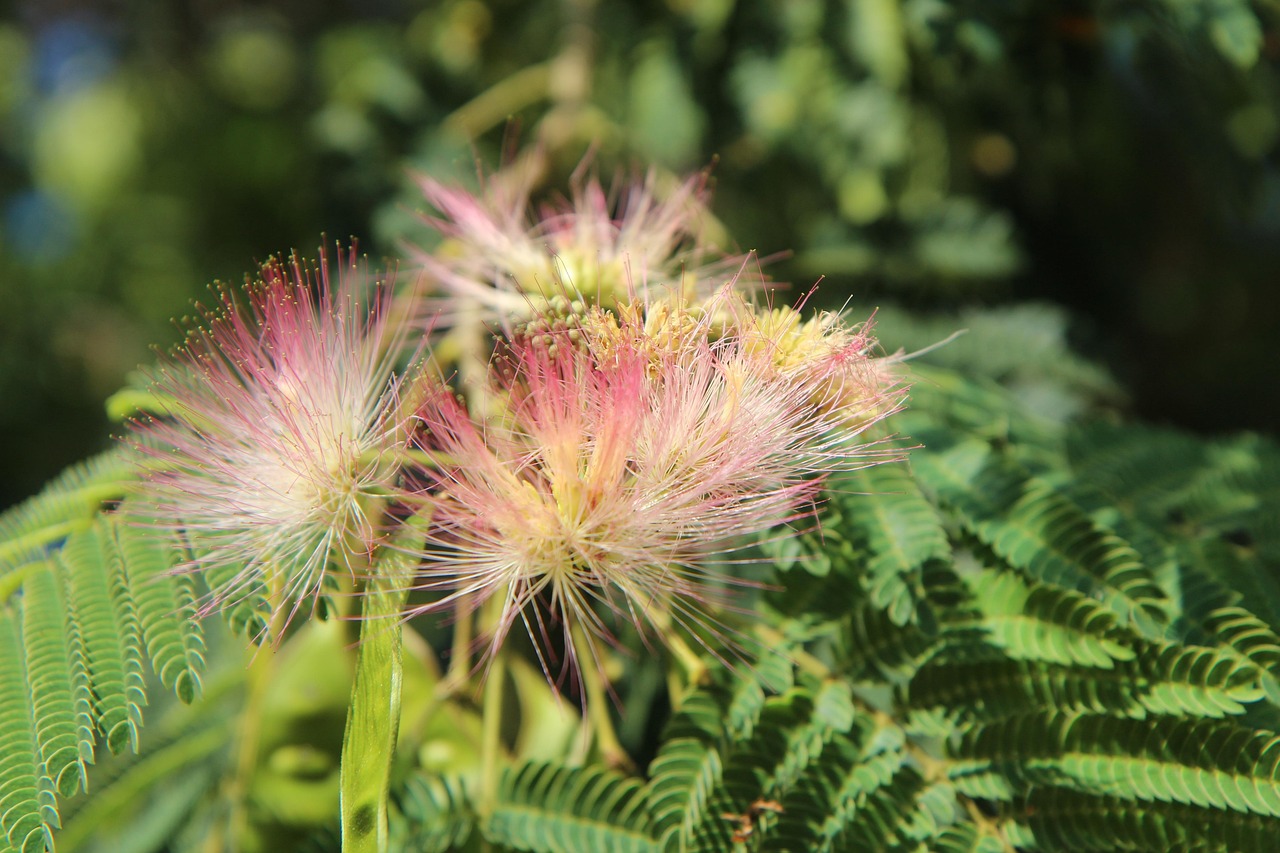The Mimosa tree, known for its rapid growth and stunning pink flowers, can reach up to 10-20 feet in height within just a few years. Its flowering patterns typically bloom in late spring to summer, creating a vibrant display that attracts pollinators.
The Mimosa tree, scientifically known as Albizia julibrissin, is native to Asia but has become popular in many parts of the world for its ornamental beauty. With its delicate, fern-like leaves and fluffy pink flowers, this tree is often sought after for landscaping and garden design. Understanding the growth rate and flowering patterns of the Mimosa tree can help gardeners cultivate it effectively and appreciate its beauty.

Mimosa trees are fast-growing deciduous trees that thrive in warm climates. They prefer well-drained soil and full sun exposure, making them ideal for gardens that receive plenty of sunlight. The growth rate of the Mimosa tree can be influenced by various factors including soil quality, climate, and care practices. Generally, these trees can grow anywhere from 3 to 5 feet per year under optimal conditions.
Growth Rate of the Mimosa Tree
The growth rate of the Mimosa tree is one of its most attractive features for gardeners. In ideal conditions, a young Mimosa tree can grow rapidly, reaching a height of 10 to 20 feet within just a few years. This quick growth makes it an appealing choice for those looking to create immediate shade or visual interest in their landscapes.
Several factors influence the growth rate of the Mimosa tree:

- Soil Quality: Well-draining soil rich in organic matter can significantly enhance growth.
- Watering: Regular watering during dry spells helps maintain healthy growth.
- Sunlight: Full sunlight exposure is essential for optimal growth rates.
- Climate: Mimosa trees thrive in warm climates and may struggle in colder regions.
- Pruning: Proper pruning can encourage bushier growth and more flowering.
In addition to these factors, it is important to note that while the Mimosa tree grows rapidly, it is also known for its short lifespan, which typically ranges from 15 to 25 years. Despite this, its fast growth makes it an attractive option for temporary landscaping solutions or quick shade provision.
Pink Flowering Patterns
The hallmark of the Mimosa tree is undoubtedly its stunning pink flowers. These fluffy blooms are not only visually striking but also play a crucial role in attracting pollinators like bees and butterflies. The flowering season usually begins in late spring and can last through the summer, depending on local climate conditions.
The pink flowers are composed of numerous long stamens that give them a pom-pom appearance. They grow in clusters and can create a beautiful spectacle when in full bloom. Here are some key characteristics of the flowering patterns:

| Flower Characteristics | Description |
|---|---|
| Color | Bright pink with a fluffy texture |
| Bloom Time | Late spring to summer |
| Fragrance | Lightly sweet aroma |
| Attracts | Bees, butterflies, and hummingbirds |
The vibrant pink flowers not only enhance the visual appeal of gardens but also contribute to local ecosystems by providing food sources for various pollinators. This makes the Mimosa tree an excellent choice for gardeners interested in supporting wildlife while beautifying their outdoor spaces.
In summary, the Mimosa tree exhibits a remarkable growth rate coupled with striking pink flowering patterns. These attributes make it a popular choice for landscaping projects aimed at creating a lively and inviting atmosphere. Understanding how to care for this tree will allow gardeners to enjoy both its rapid growth and beautiful blooms for years to come.
Care and Maintenance of the Mimosa Tree
Caring for a Mimosa tree is essential to ensure its vigorous growth and vibrant blooms. While they are generally low-maintenance, providing the right conditions can significantly enhance their health and longevity. This section will cover important aspects of care, including watering, fertilization, pruning, and pest management.
Watering Requirements
Proper watering is crucial for a young Mimosa tree’s establishment and growth. Here are some key points to consider:

- Initial Watering: Newly planted Mimosa trees require regular watering to help their roots establish. Water deeply once or twice a week during the first growing season.
- Established Trees: Once established, Mimosa trees are relatively drought-tolerant. However, they still benefit from supplemental watering during prolonged dry spells.
- Avoid Overwatering: Ensure that the soil drains well. Overwatering can lead to root rot.
Fertilization Practices
While Mimosa trees do not have high nutrient requirements, applying fertilizer can promote healthy growth and flowering. Consider these practices:
- Type of Fertilizer: Use a balanced slow-release fertilizer with equal parts nitrogen, phosphorus, and potassium.
- Timing: Fertilize in early spring as new growth begins and again in mid-summer if needed.
- Application: Follow the manufacturer’s instructions for application rates to avoid nutrient burn.
Pruning Techniques
Pruning is an important aspect of Mimosa tree care that encourages a healthy structure and enhances flowering. Here are some guidelines for effective pruning:
- When to Prune: The best time to prune is in late winter or early spring before new growth starts.
- Removing Dead or Damaged Branches: Regularly inspect the tree for any dead, damaged, or crossing branches and remove them to promote better airflow.
- Shaping the Tree: Light pruning can shape the tree and control its size. Aim for an open center to allow sunlight penetration.
Pest and Disease Management
Mimosa trees are generally resilient but can be susceptible to certain pests and diseases. Awareness of potential issues allows for timely intervention. Here are some common pests and diseases that affect Mimosa trees:
Common Pests
- Mimosa Webworm: This pest creates web-like structures on the tree and can defoliate the leaves. Regular inspection and removal of webs can help control their population.
- Aphids: These small insects suck sap from new growth, leading to stunted growth. Use insecticidal soap or neem oil as a treatment.
- Scale Insects: Scale can appear as small bumps on branches. They can be controlled with horticultural oil sprays.
Diseases
Mimosa trees may also encounter a few diseases, though they are not overly common:
- Root Rot: Caused by overwatering or poor drainage, root rot is a serious issue. Ensure proper soil drainage to prevent this.
- Powdery Mildew: This fungal disease creates a white powdery coating on leaves. Good air circulation and avoiding overhead watering can help prevent it.
Environmental Considerations
The Mimosa tree can thrive in a variety of environmental conditions, but certain factors can enhance its growth and flowering potential. Understanding these conditions is crucial for successful cultivation.
Soil Preferences
Mimosa trees prefer well-drained soil that is rich in organic matter. Here are some considerations for soil preparation:
- Soil pH: Aim for a pH between 6.0 and 7.0, which is slightly acidic to neutral.
- Add Organic Matter: Incorporate compost or well-rotted manure into the planting hole to improve soil fertility.
- Avoid Heavy Clay: Heavy clay soils retain too much moisture, which can be detrimental to roots.
Sunlight Requirements
Mimosa trees thrive in full sun, requiring at least six hours of direct sunlight daily. Here are tips for ensuring adequate sunlight exposure:
- Select an Open Location: Choose a planting site that is free from shade from buildings or other trees.
- Avoid Competition: Keep competing vegetation clear around the base of the tree to ensure it receives ample sunlight.
By understanding these care practices and environmental needs, gardeners can successfully cultivate Mimosa trees that provide stunning pink blossoms and thrive in their landscapes.
Propagation Methods for the Mimosa Tree
Propagation is the process of creating new plants from existing ones. For those interested in growing a Mimosa tree, several methods can be employed. Each method has its own set of advantages and challenges. This section will explore the most common propagation techniques for Mimosa trees: seed propagation, cuttings, and grafting.
Seed Propagation
Seed propagation is one of the simplest and most common ways to grow a Mimosa tree. Here’s how to successfully propagate Mimosa trees from seeds:
- Seed Selection: Choose healthy seeds from a mature Mimosa tree. Seeds are typically found in pods that turn brown when ripe.
- Scarification: Mimosa seeds have a hard outer shell. To improve germination rates, it is advisable to scarify the seeds. This can be done by soaking them in hot water for a few hours or gently nicking the seed coat with a knife.
- Soil Preparation: Prepare a seed-starting mix that is well-draining. A mix of equal parts peat moss and perlite works well.
- Sowing Seeds: Plant the seeds about half an inch deep in the prepared soil. Water lightly after planting.
- Germination Conditions: Place the pots in a warm location with indirect sunlight. Maintain soil moisture but avoid waterlogging.
- Transplanting: Once seedlings have grown several inches tall and developed a few sets of true leaves, they can be transplanted into larger pots or directly into the garden.
Propagation by Cuttings
Another effective method for propagating Mimosa trees is through cuttings. This method allows gardeners to clone existing trees. Follow these steps for successful cutting propagation:
- Timing: Take cuttings in late spring or early summer when the tree is actively growing.
- Selecting Cuttings: Choose healthy, non-flowering stems that are around 6 to 8 inches long. Ensure that each cutting has at least two nodes.
- Treating Cuttings: Dip the cut end of each cutting in rooting hormone to encourage root development.
- Planting Cuttings: Insert the cut end into a well-draining potting mix. Water lightly and cover with a plastic bag or dome to maintain humidity.
- Caring for Cuttings: Place the cuttings in a warm location with indirect sunlight. Keep the soil moist but not soggy.
- Root Development: After several weeks, check for root development by gently tugging on the cutting. Once roots are established, they can be transplanted.
Grafting Techniques
Grafting is less common for Mimosa trees but can be an effective way to propagate specific cultivars. This method involves joining a piece of one plant (the scion) to another (the rootstock). Here are the basic steps for grafting:
- Selecting Rootstock and Scion: Choose healthy rootstock and scion materials from desirable Mimosa tree varieties.
- Making Cuts: Create a clean cut at an angle on both the rootstock and scion to ensure good contact between the two surfaces.
- Joining: Align the cambium layers of the scion and rootstock. Secure them together using grafting tape or wax.
- Caring for Grafted Plants: Keep the grafted plant in a warm, humid environment until it heals and begins to grow.
Pests and Beneficial Insects
While Mimosa trees can face challenges from pests, they also attract beneficial insects that can help maintain a healthy garden ecosystem. Understanding both aspects is important for effective garden management.
Pest Overview
Mimosa trees are susceptible to several pests, as mentioned earlier. Here’s a brief overview of common pests that may affect them:
- Mimosa Webworm: Defoliates leaves and creates webs, particularly during summer months.
- Aphids: Small, sap-sucking insects that can weaken plants by feeding on new growth.
- Scale Insects: These pests can cause yellowing leaves and reduced vigor by feeding on plant sap.
Beneficial Insects
The presence of beneficial insects in your garden can help control pest populations naturally. Here are some beneficial insects that may be attracted to your Mimosa tree:
- Lacewings: These insects feed on aphids and other soft-bodied pests, helping to keep their populations in check.
- Ladybugs: Known for their appetite for aphids, ladybugs can significantly reduce pest numbers in gardens.
- Parasitic Wasps: Some wasps lay eggs inside pest insects, which helps regulate their populations.
By fostering an environment that attracts beneficial insects while managing pests effectively, gardeners can maintain healthy Mimosa trees and encourage biodiversity in their landscapes.
Landscape Uses and Aesthetic Appeal of the Mimosa Tree
The Mimosa tree is not only valued for its rapid growth and beautiful pink flowers but also for its versatility in landscaping. Its unique characteristics make it suitable for various applications in both residential and commercial gardens. This section will explore the different landscape uses and the aesthetic appeal of the Mimosa tree.
Ornamental Value
The Mimosa tree is often planted as an ornamental specimen due to its striking appearance. Here are some reasons why it is a popular choice:
- Vibrant Flowers: The fluffy pink blossoms create a stunning visual display during the blooming season, making them a focal point in any garden.
- Unique Foliage: The fern-like leaves provide a delicate texture that contrasts beautifully with other plants and flowers.
- Seasonal Interest: The tree offers seasonal interest, with lush foliage in spring and summer, followed by a bare structure in winter that can add architectural appeal.
Shade Provider
Mimosa trees can grow to a height of 10 to 20 feet, providing ample shade in outdoor spaces. Here are some benefits of planting them for shade:
- Cool Retreat: The dense canopy offers relief from the hot sun, making outdoor areas more enjoyable during warm months.
- Social Spaces: Creating shaded areas with seating can enhance outdoor living spaces, encouraging relaxation and social gatherings.
Wildlife Habitat
The Mimosa tree plays a crucial role in supporting local wildlife. Its flowers attract various pollinators, while its foliage can serve as shelter for small birds and insects. Here are some ways Mimosa trees contribute to biodiversity:
- Pollinator Support: The blooms are rich in nectar, drawing bees, butterflies, and hummingbirds, which are essential for pollination in many plants.
- Nesting Sites: The tree provides safe nesting sites for birds, contributing to avian diversity in the area.
Challenges and Considerations
While the Mimosa tree has many benefits, there are also challenges associated with its growth and maintenance. Being aware of these challenges can help gardeners make informed decisions:
Invasive Potential
Mimosa trees have the potential to become invasive in certain regions. Here are some points to consider regarding their growth behavior:
- Seed Production: The tree produces a large number of seeds that can spread easily, leading to unwanted growth in natural areas.
- Control Measures: Gardeners should monitor growth and control seed dispersal to prevent the tree from establishing in undesired locations.
Short Lifespan
The lifespan of the Mimosa tree is typically shorter than that of many other trees, ranging from 15 to 25 years. This means gardeners should plan for eventual replacement or maintenance. Here are some considerations:
- Regular Maintenance: Keeping the tree healthy through adequate care can maximize its lifespan.
- Replacement Planning: Consider planting other long-lived species alongside Mimosa trees to ensure continued landscape beauty as they mature.
Final Thoughts
The Mimosa tree stands out as a remarkable addition to any landscape. Its rapid growth rate, stunning pink flowering patterns, and ability to attract wildlife make it an attractive choice for gardeners looking to enhance their outdoor spaces. However, it is essential to understand both the benefits and challenges associated with this tree to ensure successful cultivation.
By providing proper care, including adequate watering, fertilization, and pest management, gardeners can enjoy the beauty of the Mimosa tree throughout its growing cycle. Furthermore, being aware of its invasive potential allows for responsible planting practices that protect local ecosystems.
In conclusion, the Mimosa tree offers aesthetic appeal and ecological benefits, making it a popular choice for landscaping. With thoughtful care and management, this beautiful tree can thrive for years, providing vibrant blooms and shade while supporting local wildlife.
